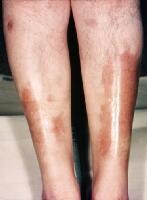Clinical findings – distal axonopathy (numbness) + central myelopathy(loss of position sense)
Lab findings – anemia (megaloblastic) + HB a1c < 7 (good glycemic control)
Loss of position sense is an early sign of vitamin B12 deficiency.
What is the most likely cause? Every option has an association with Vitamin B 12 deficiency (they are not direct causes of the deficiency) but only chronic metformin use is a direct cause. Metformin reduces vitamin B12 absorption by inhibiting calcium dependent ileal membrane transport of this vitamin. Vitamin B12 and calcium supplementation is the only effective way to alleviate the symptoms of central myelopathy.
Diabetic patients who develop loss of joint position sense should be treated with Vitamin B 12. Thyroid deficiency does not directly cause central myelopathy. Chronic metformin use is an independent cause of Vitamin B 12 deficiency that should be treated with Vitamin B 12 & calcium supplements.
Complex regional pain syndrome (CRPS)
- severe burning pain
- pathological changes in bone and skin
- excessive sweating
- tissue swelling
- extreme sensitivity to touch
If complex regional pain syndrome isn't diagnosed and treated early, the disease may progress to more disabling signs and symptoms. These may include:
- Tissue wasting (atrophy). If you avoid moving an arm or a leg because of pain or if you have trouble moving a limb because of stiffness, your skin, bones and muscles may begin to deteriorate.
- Muscle tightening (contracture). You may also experience tightening of your muscles. This may lead to a condition in which your hand and fingers or your foot and toes contract into a fixed position.
Medications Doctors use various medications to treat the symptoms of complex regional pain syndrome.
- Pain relievers. Over-the-counter (OTC) pain relievers, such as aspirin, ibuprofen (Advil, Motrin, others) and naproxen (Aleve), may ease pain and inflammation.
- Antidepressants and anticonvulsants. Sometimes antidepressants, such as amitriptyline, and anticonvulsants, such as gabapentin
- Corticosteroids. Steroid medications, such as prednisone, may reduce inflammation and improve mobility in the affected limb.
- Bone-loss medications. Your doctor may suggest medications to prevent or stall bone loss, such as alendronate (Fosamax) and calcitonin (Miacalcin).
- Sympathetic nerve-blocking medication. Injection of an anesthetic to block pain fibers in your affected nerves may relieve pain in some people.
Therapies
- Applying heat and cold. Applying cold may relieve swelling and sweating. If the affected area is cool, applying heat may offer relief.
- Topical analgesics. Various creams are available that may reduce hypersensitivity, such as lidocaine or a combination of ketamine, clonidine and amitriptyline.
- Physical therapy. Gentle, guided exercising of the affected limbs may help decrease pain and improve range of motion and strength. The earlier the disease is diagnosed, the more effective exercises may be.
- Transcutaneous electrical nerve stimulation (TENS). Chronic pain is sometimes eased by applying electrical impulses to nerve endings.
- Biofeedback. In some cases, learning biofeedback techniques may help. In biofeedback, you learn to become more aware of your body so that you can relax your body and relieve pain.
- Spinal cord stimulation. Your doctor inserts tiny electrodes along your spinal cord. A small electrical current delivered to the spinal cord results in pain relief.
Osteonecrosis of the Hip

Diagnosis and treatment
It is estimated that doctors see about 10,000-20,000 new cases of osteonecrosis (ON) each year. No one knows exactly what causes it. See your doctor if you start feeling a dull ache or throbbing pain to the side of your hip in the groin or buttock and you have osteonecrosis risk factors including:
It is estimated that doctors see about 10,000-20,000 new cases of osteonecrosis (ON) each year. No one knows exactly what causes it. See your doctor if you start feeling a dull ache or throbbing pain to the side of your hip in the groin or buttock and you have osteonecrosis risk factors including:
- Age 20-50 years.
- Hip dislocation or fracture.
- Alcoholism.
- Corticosteroid use.
- Glandular problems and diseases including rheumatoid arthritis, sickle cell disease, myeloproliferative disorders, Gaucher's disease, chronic pancreatis, Crohn's disease, Caisson's disease or systemic lupus erythematosus.
Your doctor may flex and rotate your hips to check for pain. Your hips may be X-rayed and possibly scanned by MRI (magnetic resonance imaging) to see if bone marrow is dying or dead, and how much the head of your femur may have collapsed.
- If you have ON and the head of your femur is not yet collapsed, certain medical procedures (i.e.: decompression and bone grafting) may help your body build new blood vessels and bone cells to replace the dead ones.
- If ON has already collapsed your hip, total hip replacement surgery (arthroplasty) may eliminate your pain and give you better hip mobility. A ball and socket replaces your hip joint. Your thighbone is fitted with the ball piece, which takes the place of the head of your femur. Your hip socket is fitted with the socket piece (cup).







